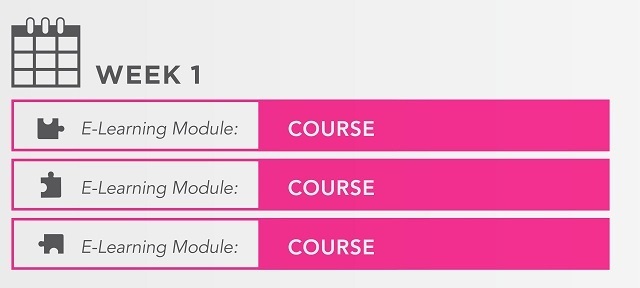Content Digitization: Choosing The Right Online Course Formats
Today, would you dream of taking a camera and simply filming a journalist from a radio news show to run on the evening news? Of course not! Without narration, multiple cameras, cutaway views and close-ups of the presenter, viewers would lose interest after 2 minutes.

The same phenomenon is at work in digital media. Rather than simply transposing a course, you have to rethink how the material is delivered. You must properly understand digital use cases in order to create a dynamic, interactive course with content that will engage students. Properly structuring your course is essential for achieving these goals.
When designing a course, 3 different modules can be used: attended classes, eLearning modules, or webinars. If eLearning modules or webinars are used, the course can be considered “digital”. However, it is the number and structure of these different modules that will determine the overall course format; an online training course can certainly include classroom sessions as well.
Even in the digital era, teaching objectives remain unchanged – at the end of the course, students must have acquired a certain number of pre-defined skills or concepts. To efficiently digitize content, the challenge consists in identifying essential key topics and breaking them into teaching blocks. Each topic and related sub-topics will result in a training module chosen from 3 types as described above.
1. 100% Online Learning
Online learning can be asynchronous[1] or synchronous and consist of 2 types of modules: eLearning and webinars.
An online-only course can vary greatly in terms of length, weekly workload, and, ultimately, the number of course modules. On average, a course lasts 1 to 3 weeks, with 30 minutes to 1 hour of weekly coursework. If the instructor does not want to work synchronously, a typical course will consist of 2 to 3 eLearning modules per week. Each module lasts on average 15 minutes and a maximum of 30 minutes. The second-to-last module is used for an exam made up of various questions, with a certificate being awarded if a minimum score is reached. The last module is reserved for gathering feedback and for discussing course topics in a more general setting. If the instructor wants to add webinar modules to the course, they generally take place every 2 weeks and last 1 hour.
It is certainly possible to create longer courses or modules, but the risk of losing student engagement increases proportionally. Your content is fighting for your audience’s attention alongside the whole of the internet. Student’s are constantly tempted to open a new browser tab and check out what is happening on Facebook or YouTube. Keep courses short and punchy, that is your best weapon.
Tips And Tricks
If you transpose traditional content into digital content, 1 classroom hour is generally equivalent to a 10 to 20 minute eLearning module. It is important to focus on key points and essential knowledge.

Charts: Connection loss based on course size, 2nd graph based on the module size (source: 360L Research Institute) / Credit: 360Learning
An average eLearning module consists of ten activities: 5 or 6 documents, 3 or 4 questions, and a course outline. An eLearning exam module generally uses a document or outline followed by 15 to 20 questions. The document should explain the exam format and contain any needed context or instructions. Questions should be a mix of traditional and more playful formats.


Example structure for an online-only course / Credit: 360Learning
2. Blended Learning
In a blended learning course, also known as “hybrid” or “mixed-mode” courses, eLearning modules and webinars are paired with traditional classroom sessions. With this combination, students benefit from the best of both worlds. During class, the instructor focuses on practical exercises including case studies, situational exercises, role-playing, and one-to-one explanations. Online modules reinforce theoretical topics and evaluate comprehension levels to generate statistics. Webinars allow students to ask questions and are ideal for clarifying specific topics.
Blended learning courses also vary greatly in length and intensity. On average, courses last 2 to 3 weeks and consist of the following: 2 eLearning modules per week, 1 face-to-face class per week (usually between the 2 eLearning modules), and a webinar half-way through the course, more if attended classes are canceled. As with online-only training, the second-to-last eLearning module is typically used to evaluate the knowledge acquired throughout the course. The same goes for the last module, used to gather feedback and discuss the course topic in a more general setting. As opposed to an online-only course, the first module of an eLearning course can also be used for an assessment. The added value of blended learning is being able to show the “before and after” effect and demonstrate what core knowledge was acquired throughout the course.
Tips And Tricks
Be aware that all blended learning courses contain at least 1 attended class.
eLearning modules are structured the same as they are for online-only courses.


Example structure for a blended learning course / Credit: 360Learning
3. External MOOCS
As with blended learning courses, external MOOCs can be composed of different types of modules, although attended classes are optional. MOOCs, however, require a specific set-up that make them unique. They last on average 4 weeks, with 1 to 2 hours of weekly coursework. eLearning modules are used for teaching core topics and for evaluating acquired knowledge at the end of each module. Two eLearning modules, one halfway through the MOOC and one at the end, are used for exams. Webinars, called Hangouts or LiveStreams, are mainly used for interviewing guest speakers or for Question and Answer sessions with the instructor. Attended classes, called Meetups, are designed to generate participation and discussion amongst MOOC attendees. Meetups can be organized by the educator or by participants themselves.
Concretely, an external MOOC generally consists of 2 eLearning modules per week, 1 to 2 Meetups, and 1 to 2 Hangouts. MOOC content consists mainly of videos; this is one of their defining characteristics. The eLearning module will therefore be comprised mostly of (optional) audiovisual material and 2 to 3 questions to validate acquired knowledge. At most, they are composed of 10 to 15 activities.
Upon completion of an external MOOC, a certificate is awarded. It is generated automatically by the platform and contains a unique ID number that can be verified by an employer. This certificate serves as proof that the MOOC was completed and that minimal exam scores were obtained.




Example structure for an external MOOC / Credit: 360Learning
4. Internal MOOCS
As with external MOOCs, internal MOOCS can be composed of different modules and have a very similar structure overall. The differences are found in course length and the public they address. Whereas external MOOCs target all users, internal MOOCs target smaller, niche audiences. They generally aim to align employee skills with market needs and industry standards. Internal MOOCS use the same teaching methods as external MOOCs but apply them in a closed environment, with business objectives. They are often presented in groups because of their multitude.
They should not last longer than 1 or 2 weeks. Each training module should be short, on average 5 to 15 minutes. It is better to produce more, shorter, internal MOOCs, than fewer, longer courses.

Example structure for an internal MOOC / Credit: 360Learning
5. SPOCS
The Small Private Online Course, or SPOC, appeared shortly after the MOOC and has a very similar structure. They also last on average 4 weeks, with 1 to 3 hours of weekly coursework.
What characterizes a SPOC?
- Each SPOC has a limited number of participants, on average 50. As a result, there may be multiple sessions of the same SPOC per year.
- Each participant is coached daily, either in-class or via LMS. During the course, all participants work on an ongoing project, either individually or in groups. For example, during a course studying new tools for improving productivity, students could be asked to identify daily tasks that are unproductive and suggest how the new tools / software could improve the situation.
These specificities require a slightly different course structure, focused on individual coaching and overseeing projects. Attended classes and webinars are used to monitor projects and take place more frequently, on average once a week. As with MOOCs, SPOCs are composed mainly of audiovisual content and 2 or 3 assessment questions. They contain at most 10 to 15 activities. Ultimately, SPOCs are slightly more intense for students than other formats.




Example structure for a SPOC / Credit: 360Learning
If you want to learn more about designing, producing, distributing, and hosting online courses, download the eBook Training In An Online World.
Footnote:
- Synchronous learning requires that individuals be present at the same time, either in person or online. For example, during a webinar or classroom session. Asynchronous modules are available at any time, you do not have to be in a specific place at a given time. For example, training videos.









